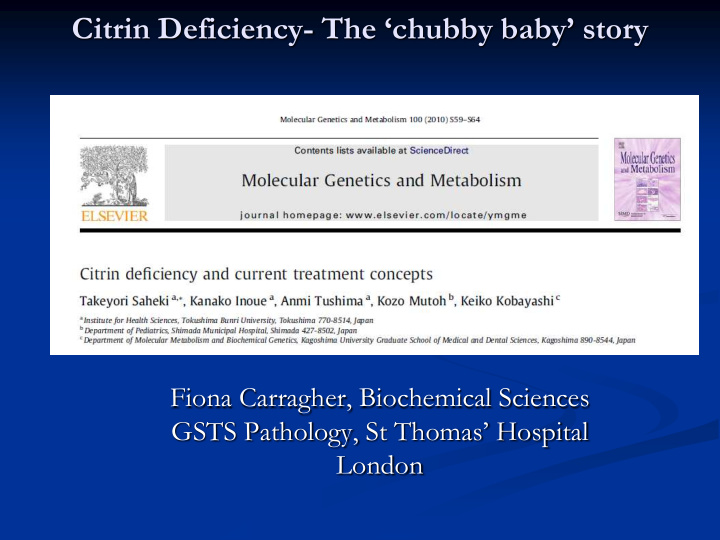



Citrin Deficiency- The ‘chubby baby’ story Fiona Carragher, Biochemical Sciences GSTS Pathology, St Thomas’ Hospital London
Citrin Deficiency First described in Japan/East Asia Now increasingly recognised worldwide Mutations in SLC25A13 gene (chr 7q21.3) which encodes citrin Mitochondrial aspartate-glutamate carrier (AGC) Two distinct disease entities Adult onset type II Citrullinaemia (CTLN2) Neonatal intrahepatic cholestasis (NICCD)
Citrin – two key roles Gluconeogenesis from lactate Transports cytosolic NADH-reducing equivalents in mitochondria Part of malate-aspartate shuttle Ureogenesis from ammonia Provides aspartate from mito to cytosol Required for synthesis of proteins, nucleotides and urea
Functions of Citrin
Citrullinaemia Type I (classical) Argininosuccinate synthetase (ASS) deficiency Increased Citrulline Decreased Arginine Urine orotic acid Classically presents with hyperammonaemia in newborn period
Citrullinaemia Type II (CTLN2) Liver specific decrease in ASS activity Secondary to citrin deficiency Citrullinaemia present during hyperammonaemia Exact cause not clear Hyperammonaemia in early adulthood Neuropsychiatric symptoms Disorientation and delirium Seizures and Coma Mortality Non-alcoholic fatty liver disease Not-overweight
Neonatal Intrahepatic Cholestasis (NICCD) Neonatal cholestasis Growth retardation /FTT Severe intrahepatic Cholestasis Multiple metabolic abnormalities Aminoacidaemia (cit/thr/met/tyr/arg) Galactosaemia Hypoproteinaemia Fatty liver
NICCD- clinical course Severe symptoms during infancy Symptoms often resolve in first year Healthy period may last decades Some patients develop severe CTLN2 May require liver transplantation More recently symptomatic groups described during ‘healthy period’
Clinical course of NICCD
The Chubby Index
Disappears by one year!
Characteristic food preference NICCD have a characteristic food preference Carbohydrate avoidance Prefer protein and fat rich foods Markedly different from know UCD (protein avoid)
Carbohydrate toxicity Yazaki et al (2005) 14 cases with hyperammonaemic brain oedema 12/14 treated with glycerol died 2/14 treated with mannitol survived Case study 13yr old girl Citrin def Sister with CTLN2 – liver transplant Fatigue, skinniness, abdominal disorder
Case study High CHO diet Drowsy with increase NH4 ‘Normal’ diet, high protein/fat Slight increase NH4 Linear relationship glucose to ammonia
Ureagenesis in citrin def Under controlled state Glu formed from NH3 leaves mito instead of Asp Converted in cytosol to Asp by aspartate aminotransferase Formed Asp used by ASS and formation of citrulline Urea may be synthesised in citrin def
Link to carbohydrate toxicity Oxaloacetate essential, formed from malate Reaction requires NADH to be oxidised If increased CHO load in citrin def NADH accumulates Urea cycle inhibited as asp cannot be formed Glycolysis inhibited causing energy deficit
Treatment options Standard therapy Low protein/ high CHO diet May cause hyperammonaemia in Citrin def Most effective is Liver Tx Metabolically normal (but long term immunosup) Low CHO/high protein diet is effective Sodium pyruvate may be effective Oxidises NADH
Recommend
More recommend